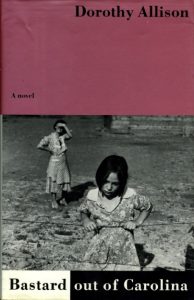Make Lit Class Great Again: Bastard out of Carolina by Dorothy Allison
Christina Bagni//Blog Writer
Dorothy Allison’s novel Bastard out of Carolina has the voice of To Kill a Mockingbird, the detailed characters of Beloved, and the suspense of a Stephen King novel. It is rare to see an honest, unfiltered depiction of a poor, southern, white family, and even rarer to see it through the eyes of a child. I feel very lucky to have been assigned this novel for my Art of Fiction class.

Ruth Anne Boatwright—nicknamed Bone, because when she was born she was ‘no bigger than a knuckle bone’—grows from five years old to just shy of thirteen, and in these short eight years we see her and her family grow and change. Her mother is single and poverty-stricken, trying hard to raise her two daughters with support of a waitressing job and her close-knit family. She marries a man Bone is told to call Daddy Glen, and at first it seems like a good change for the family with extra income, a nicer house, and a male role model for the girls who isn’t in and out of jail like their uncles are.
Bone’s life takes a tragic turn when Daddy Glen’s son dies in childbirth. As he and Bone are waiting at the hospital in the car, he sexually abuses her. The scene is visceral; the details are sickening, especially when filtered through the innocent eyes of a child. The girl is confused and hurt, and it sticks with her for years. Over time, the abuse happens more and more often, interspersed with beatings so severe they break Bone’s ribs and tailbone. Bone’s mother stays with him, as she only knows about the beatings and not the rape, and begs Bone to behave.
The suspense of Daddy Glen’s presence and Bone’s silence drives the story. Seeing Bone play with her friends and bond with her aunts and mother gives the story the glow of childhood, and it is written in such a way that one understands Bone’s frightened, confused embarrassment and her subsequent silence that drags for years.
The star feature of the novel is truly the first person narrative voice of Bone. Though she deals with constant fear of her stepfather, she still gets into playful mischief with her friends and cousins. She falls in love with gospel music and books, she excels in school, she sings to old records and makes friends and argues with her sister. Allison does an amazing job of making Bone feel like a real kid—poor and abused, yes, but a real kid. Daddy Glen and Bone’s mother are also humanized. He is not a monster and she is not weak, and this dynamic makes the abuse all the more real and frightening.
Overall, this is a fantastic novel that any aspiring writer could learn a lot from. The character, dialogue, voice, and tone are masterful, and the way Allison describes the South is beautiful in its avoidance of stereotype and fearlessness of the gritty truths sewn into the patchwork of childhood. A gorgeously tragic photograph of the South, I would recommend this book to anyone who likes the tone and question of innocence of To Kill A Mockingbird, with the warning that there are some very graphic and potentially triggering scenes of sexual abuse.
